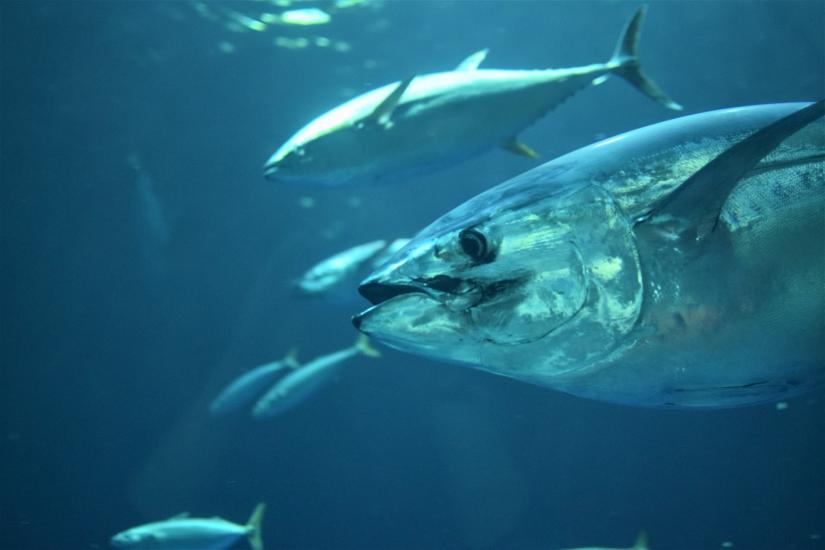Pacific Bluefin Tuna
Thunnus orientalis
The Science
THE SCIENCE
Found as deep as 550 m (1800 ft) and can weigh up to 450 kg (990 lbs)!

Taxonomic description
- Body is streamlined and black or blue with grey-green iridescence; underside has spots of silver or grey, which appear as bands; second dorsal to tail fins are yellow with black edges. [1]
- Tip of the pectoral fin does not reach the front of the second dorsal fin and has a lunate tail. [1]
- Averages 1.5 m (4 ft 11 in), in length and weights around 60 kg (130 lbs), with record length of 3 m (9 ft 8 in), and weight of 450 kg (900 lbs)! [1]
Distribution
- Primarily found in sub-tropical and temperate Pacific Ocean between 20-50 degrees North; also in tropical waters off New Zealand in the Tasman Sea. [3]
Life history
- Spawns from mid-April to June, in the Sea of Japan and the southwestern North Pacific Ocean, during this time the females produce up to 10 million eggs a year. [1]
- When young, it migrates over 8,000 km (5,000 mi) from the Sea of Japan to the coast of California to feed and grow for several years. [9]
- Travels up and down the California coast between Washington and Mexico until about the age of 7 when it returns to the coast of Japan to spawn. [9]
- Matures at around 5 years and has a life expectancy of 26 years; average lifespan is 15 years. [1]
Habitat
- Pelagic; as one of the fastest fish in the ocean, it travels in large schools in open-water, coastal sea or near seamounts. [3,1]
- Starts off its larval stage by selectively eating tiny copepods, and eventually moves up the food chain to be a generalist predator who eats a variety of prey, including squid, anchovies, and even crustaceans! [4]
- Predators of this fish include, sharks, orcas, and pilot whales; it also faces human fishing pressure which is of particular concern when targeted in spawning areas. [1]
- Migration and spawning patterns are affected by increasing ocean temperatures, acidification, and nitrate levels; and decreased dissolved oxygen concentrations and trophic production associated with climate change. [4]
The Fishery
THE FISHERY
Commercial bluefin tuna fishing usually utilizes the purse seine method, which uses floating objects to attract schools of tuna.

Seasonal availability
- Mostly caught from May to October, but also available year-round [10]
Regulatory and managing authority
- Internationally overseen by the Inter-American Tropical Tuna Commission (IATTC) and the Western and Central Pacific Fisheries Commission (WCPFC). [10]
- Along the Pacific West Coast, the fishery is overseen by NOAA fisheries and, as established by the Magnuson-Stevens Act, the Pacific Fishery Management Council through the West Coast Highly Migratory Species Fisheries Management Plan. [10]
- As established by the Marine Life Management Act, the California Department of Fish and Wildlife (CDFW) collects data on this fishery through the Pelagic Fisheries and Ecosystems Program. [19,20]
Gear type
- Primarily caught by purse seines. [6]
- Fishing gear is selective and allows for the live release of any unintentionally caught species. [1]
Status of the fishery
- Declared overfished and subject to overfishing by NOAA; overall decrease in population size since the 1950s; recently assessed at less than 6% of historic levels. [7,8]
- There is some controversy over whether or not this species is under threat of extinction, as the IUCN listed this species as 'Vulnerable' in 2014, while a 2017 NOAA study declared the species to be of low risk for extinction. [4,7,8]
- Due to concerns about overfishing, regulations now require a permit to harvest, annual quotas or subquotas, gear restrictions, time and/or area closures, and minimum size limits. [3,1]
- Bluefin tuna aquaculture has started in other regions, but not in California. [13]
Potential ecosystem impacts
- Fishery is subject to risks of bycatch associated with purse seine and longline gear types. [6,12]
- Currently, the impact of overfishing and aquaculture for this species on the pelagic food web is not well understood. [13]
The Seafood
THE SEAFOOD
Pacific bluefin tuna is typically eaten raw in sushi and sashimi.


Edible portions
- Similar to beef, different cuts of bluefin tuna meat have different names and prices. Because bluefin tuna consumption originated in Japan, these names are in Japanese. [14]
- The more common and lower-valued cuts are called akami, while the more expensive, fattier cuts are called toro. The most well-known cuts are otoro and chutoro, which come from the lower belly to the head and the belly at the center and rear, respectively. [14]
Description of meat
- Bluefin tuna is a deep red color when raw, has a high fat content, and has the firmness and appearance of beef steaks. [10,14]
Culinary uses
- Typically served raw in sushi and sashimi, and cooking is generally not advised. [10]
Nutritional information
- Considered an oily fish when raw, and is a good source of protein, thiamin, selenium, vitamin B6, and omega-3 fatty acids. [10]
- Nutritional information for 100g raw bluefin tuna on table. [10]
Seasonal availability
- This fish is available year-round, but most are caught in between May and October. [10]
References
[1] NOAA Fisheries. Pacific Bluefin Tuna. Web. https://www.fisheries.noaa.gov/species/pacific-bluefin-tuna. Accessed: 4 March 2019.
[2] Marlin (2016). The Biggest Bluefin Tuna Fishing Record: After 40 years, this catch remains the biggest tuna ever recorded by the IGFA. Web. https://www.marlinmag.com/bluefin-tuna-record-revisiting-history Accessed: 9 March 2019.
[3] Craig, M., Bograd, S., Dewar, H., Kinney, M., Lee, H., Muhling, B., Taylor, B. (2017). Status Review Report of Pacific Bluefin Tuna (Thunnus orientalis). U.S. Department of Commerce, National Oceanic and Atmospheric Administration, La Jolla, CA, USA. https://repository.library.noaa.gov/view/noaa/16990
[4] Pacific Bluefin Tuna Status Review Team (2017). Status Review Report of Pacific Bluefin Tuna (Thunnus orientalis). Report to National Marine Fisheries Service, West Coast Islands Regional Office. 1-99 https://www.westcoast.fisheries.noaa.gov/publications/fisheries/migrato…
[5] Ottolenghi, F. (2008). Capture-based aquaculture of bluefin tuna. FAO Fisheries Technical Paper. No. 508. Rome, FOA. 00. 169-182. https://pdfs.semanticscholar.org/897b/0cc729d01af30fa1be9a1dfbf71f1f651…
[6] Seafood Watch Consulting Researcher. Monterey Bay Aquarium.2018. Bigeye Tuna, Pacific Bluefin Tuna, Skipjack Tuna, Yellowfin Tuna: Unassociated purse seine (non-FAD), Floating object purse seine (FAD). https://www.seafoodwatch.org/-/m/sfw/pdf/reports/t/mba_seafoodwatch_tun…
[7] Seafood Watch Consulting Researcher. Monterey Bay Aquarium. 2016. Pacific Bluefin Tuna (Thunnus orientalis). 1-84. https://www.seafoodwatch.org/-/m/sfw/pdf/reports/t/mba_seafoodwatch_blu…
[8] NOAA Fisheries. 2018. Bluefin Tuna Stock Assessment. Web. https://swfsc.noaa.gov/textblock.aspx?Division=FRD&ParentMenuID=189&id=…. Accessed 18 March 2019.
[9] Smithsonian Institution. 2017. The Great Pacific Migration of Bluefin Tuna. Web. https://ocean.si.edu/ocean-life/fish/great-pacific-migration-bluefin-tu…. Accessed 25 Mar 2020.
[10] NOAA Fishwatch. 2019. Pacific Bluefin Tuna. Web. https://www.fishwatch.gov/profiles/pacific-bluefin-tuna?_ga=2.21138867…. Accessed 25 Mar 2020.
[11] International Seafood Sustainability Foundation. 2020. Fishing Methods: An Overview. Web. https://iss-foundation.org/about-tuna/fishing-methods/#:~:text=Pole%20a…. Accessed 1 July 2020.
[12] Seafood Watch Consulting Researcher. Monterey Bay Aquarium. 2018. Albacore Tuna, Bigeye Tuna, Pacific Bluefin Tuna, Southern Bluefin Tuna, Swordfish, Yellowfin Tuna: Drifting Longline. Web.https://www.seafoodwatch.org/-/m/sfw/pdf/reports/t/mba_seafoodwatch_alb…. Accesed 1 July 2020.
[13] AsiaPacific-Fishwatch. n.d. Pacific bluefin tuna. Web. http://www.asiapacfish.org/index.php/species/item/27-pacific-bluefin-tu…. Accessed 1 July 2020.
[14] Otoro. 2020. Delicious Otoro Sushi. Web. http://otoro.com/. Accessed 1 July 2020.
[15] aes256. 2020. Photo of bluefin tuna in Japan. Web. http://photozou.jp/photo/show/296250/118149451. Accessed 1 July 2020.
[16] Puchner, T. flickr. 2008. Roter Thun, Bluefin Tuna (Thunnus thynnus) in Thunfischmast. Digital image. Web. https://flickr.com/photos/tom_puchner/3362791138. Accessed 18 February 2021.
[17] Kate. Unsplash. 2019. Photo of bluefin tuna. Digital image. Web. https://unsplash.com/photos/BRnnJ6vVNdY. Accessed 1 July 2020.
[18] City Foodsters. flickr. 2015. Bluefin tuna (Spain). Digital image. Web. https://flickr.com/photos/cityfoodsters/16949461958. Accessed 18 February 2021.
[19] Marine Life Management Act. n.d. California Department of Fish and Wildlife. Web. https://wildlife.ca.gov/Conservation/Marine/MLMA. Accessed 24 August 2020.
[20] Overview of the Pelagic Fisheries and Ecosystems Program. n.d. California Department of Fish and Wildlife. Web. https://wildlife.ca.gov/Conservation/Marine/Pelagic#52132542-overview. Accessed 9 December 2020.



